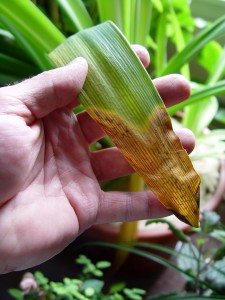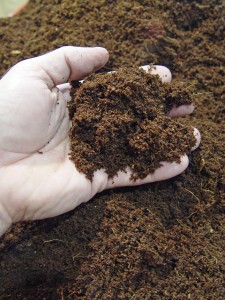Those Browning Houseplants
January 21st, 2014
This is the time of year when forced-inside gardeners look at their houseplants and get frustrated at how so many of them seem to turn brown around the leaf tips and edges.
Most people chalk it up to their own “brown thumb” or to some mysterious secret that they haven’t yet figured out.
Usually, it’s a matter of two very basic and fixable issues – water and soil.
Simple lack of water is often the main reason those leaf tips dry and die. Go away or forget to water for a couple of weeks, and that’s enough for root death to start.
Compound that with the usual dry winter air in our heated houses, and the conditions are a far cry from the humid tropics that most houseplant species call home.
Yet a lot of people swear they water regularly and still see that infernal tip browning.
That’s entirely possible, too… for two main reasons.
One is if you water so much that roots are rotting, the roots die, leaving fewer to take up water even when the soil is adequately damp.
The other is the quality of the water, which can relate back to the soil.
Many homes have water softeners, which typically use sodium to counteract the calcium that makes our water “hard.”
Excess sodium in the soil restricts roots’ ability to take up water, and the result is similar to drought symptoms – tip- and margin-browning.
Fluoride that’s added to treated public water is another little-known tip-browner – especially in sensitive species such as spider plant, dracaena and anything in the lily family.
Over-fertilizing is a related culprit. Salts in the fertilizer can build up in the soil and lead to the same problem as sodium from the water softener.
And the soil itself can contribute as the peat moss in most mixes breaks down, becomes compacted and leads to root-killing drainage and constriction issues. Salt builds up more readily in compacted soil.
What to do?
Since those are all care issues and not bug or disease problems, spraying is definitely not the answer.
Try repotting if you haven’t done that in a couple of years. A fresh mix will solve salt buildups and improve drainage.
Look for great-draining, quality mixes that are primarily compost, bark fines, coconut coir, perlite and vermiculite with little to no peat moss.
When watering, wait for the surface to dry and for the pot to feel noticeably lighter. Most houseplants resent living in soggy or constantly wet soil.
Adequate drainage holes in the pot should let water run out into your dishes or whatever you’re using to keep drainage from dripping on the carpet. Empty the dish once the water drains.
If you’ve got softened water or water treated with fluoride, consider switching to distilled water or to water you capture from rain or melted snow. Or let your tap water stand for a day or two to at least let chlorine and fluoride dissipate.
Finally, keep your plants out of the line of hot-air sources and away from cold winters. Blasts of hot, dry air or tender leaves that touch a cold window or keep getting chilled every time you open the door are prone to tip- and margin-browning.
Snip off those ugly brown existing leaves and see if the new growth doesn’t respond better to those changes.
If it doesn’t, try showing your plants pictures of your compost pile. Maybe that’ll change their attitude…









